Generation of Bio-Based, Shape- and Temperature-Stable Three-Dimensional Nonwoven Structures Using Different Polyhydroxyalkanoates
Abstract
1. Introduction
2. Materials and Methods
2.1. Materials
2.1.1. Commercial Polymers
2.1.2. Additives
2.1.3. Reference Nonwoven Fabrics
2.1.4. Commercial Plant Seed Pots (Demonstrator References)
2.2. Compounding Experiments
2.3. Meltblow Process
- Polymer throughput: max. 3.5 kg h−1;
- Process temperature (polymer, air): potentially up to 420 °C;
- Air throughput: max. 325 Nm3 h−1;
- Collector speed: max. 10 m min−1
2.4. Producution of Three-Dimensional Meltblown Samples
2.5. Material Drying and Determination of the Moisture Content
2.6. Polymer Characterization
2.7. Nonwoven Testing
2.7.1. Fabric Area Base Weight
2.7.2. Nonwoven Thickness
2.7.3. Air Permeability
2.7.4. Scanning Electron Microscopy/Fiber Diameter (Distribution)
2.7.5. Mechanical Properties
2.7.6. X-Ray Diffraction
2.7.7. Thermal Stability
2.7.8. Qualitative Evaluation of the Flexibility and Shape Retention of 3D Nonwoven Structures
3. Results and Discussion
3.1. Characterization of the Compounds
3.2. Investigation of the Meltblown Processability
3.3. Nonwoven Characteristics
3.4. Processing of Three-Dimensional Nonwoven Structures
4. Conclusions
Author Contributions
Funding
Institutional Review Board Statement
Data Availability Statement
Acknowledgments
Conflicts of Interest
Appendix A. REM Micrographs of Commercial (Reference) Plant Pots

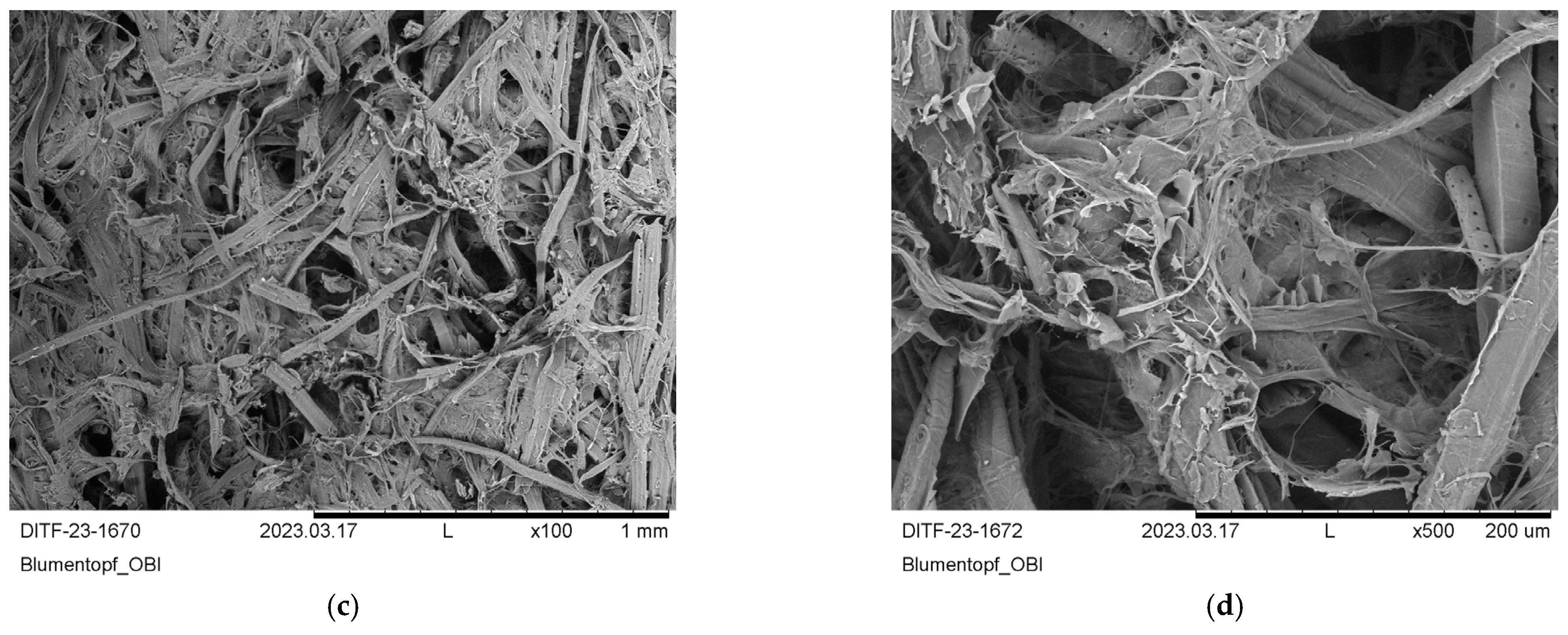
Appendix B. DSC Thermogram of PHBH Meltblown Nonwoven Material
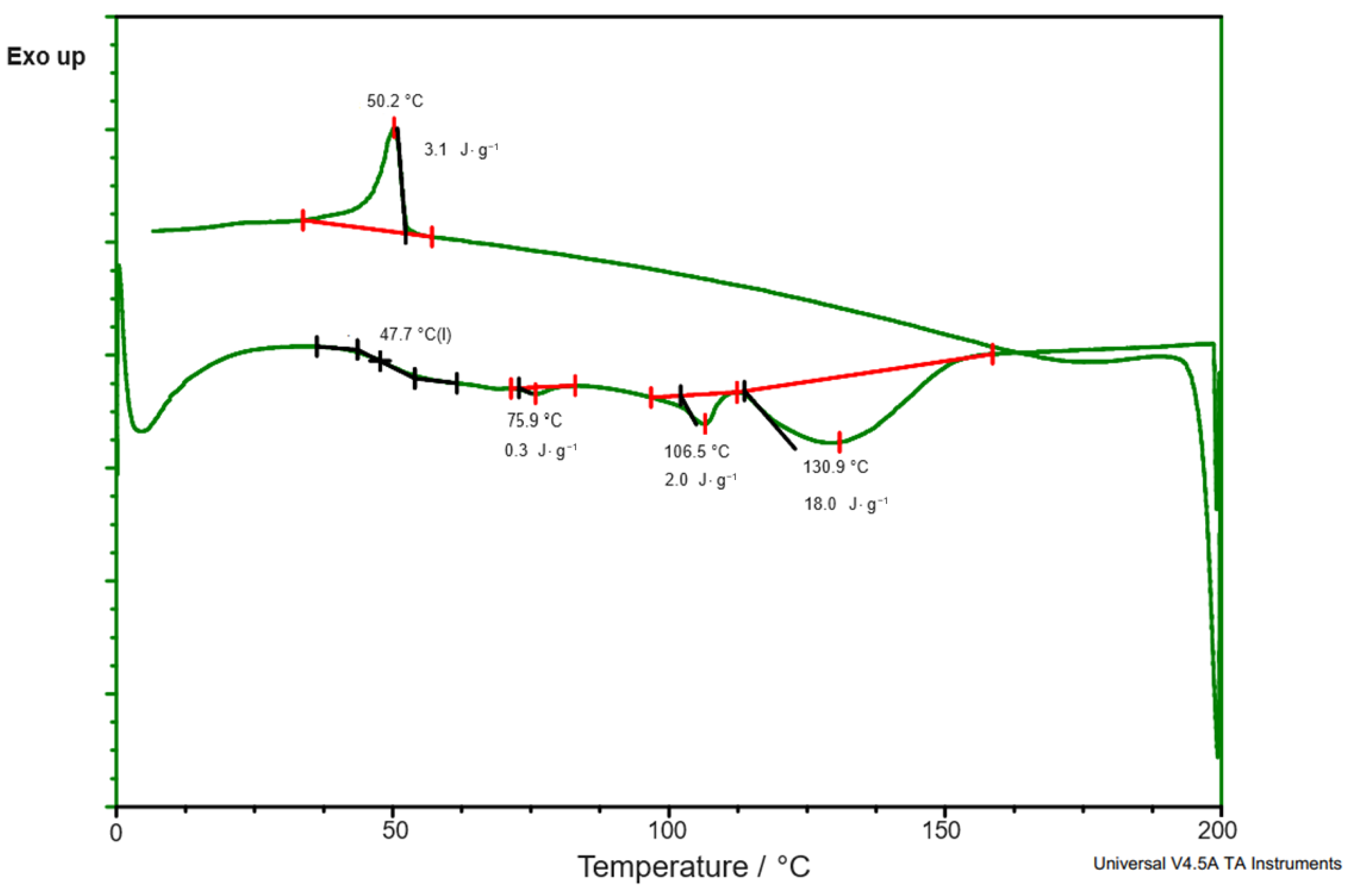
References
- Vert, M.; Doi, Y.; Hellwich, K.-H.; Hess, M.; Hodge, P.; Kubisa, P.; Rinaudo, M.; Schué, F. Terminology for biorelated polymers and applications (IUPAC Recommendations 2012). Pure Appl. Chem. 2012, 84, 377–410. [Google Scholar] [CrossRef]
- Varsha, Y.M.; Savitha, R. Overview on Polyhydroxyalkanoates: A Promising Biopol. J. Microbial. Biochem. Technol. 2011, 3, 99–105. [Google Scholar]
- Mottin, A.C.; Ayres, E.; Oréfice, R.L.; Câmara, J.J.D. What changes in poly(3-hydroxybutyrate)(PHB) when processed as electrospun nanofibers or thermo-compression molded film? Mater. Res. 2016, 19, 57–66. [Google Scholar] [CrossRef]
- Winnacker, M. Polyhydroxyalkanoates: Recent advances in their synthesis and appliations. Eur. J. Lipid Sci. Technol. 2019, 121, 1900101. [Google Scholar] [CrossRef]
- Rodriguez-Contreras, A.R. Recent advances in the use of polyhydroyalkanoates in biomedicine. Bioengineering 2019, 6, 82. [Google Scholar] [CrossRef]
- Reddy, C.S.K.; Ghai, R.; Kalia, V.C. Polyhydroxyalkanoates: An overview. Bioresour. Technol. 2003, 87, 137–146. [Google Scholar] [CrossRef]
- Marchessault, R.H. Tender morsels for bacteria: Recent development in microbial polyester. Trends. Polym. Sci. 1996, 5, 163–168. [Google Scholar]
- Köse, G.T.; Kenar, H.; Hasırcı, N.; Hasırcı, V. Macroporous poly(3-hydroxybutyrate-co–3-hydroxyvalerate) matrices for bone tissue engineering. Biomaterials 2003, 24, 1949–1958. [Google Scholar] [CrossRef]
- Hufenus, R.; Reifler, F.A.; Maniura-Weber, K.; Spierings, A.; Zinn, M. Biodegradable bicomponent fibers from renewable sources: Melt-spinning of poly(lactic acid) and poly[(3-hydroxybutyrate)-co-(3-hydroxyvalerate)]. Macromol. Mater. Eng. 2012, 297, 75–84. [Google Scholar] [CrossRef]
- Tanaka, T.; Fujita, M.; Takeuchi, A.; Suzuki, Y.; Uesugi, K.; Ito, K.; Fujisawa, T.; Doi, Y.; Iwate, T. Formation of highly ordered structure in poly[(r)–3-hydroxybutyrate-co-(r)–3-hydroxyvalerate] high-strength fibers. Macromolecules 2006, 39, 2940–2946. [Google Scholar] [CrossRef]
- Chiellini, E.; Solaro, R. Biodegradable polymeric materials. Adv. Mater. 1996, 8, 305–313. [Google Scholar] [CrossRef]
- Qin, Q.; Takarada, W.; Kikutani, T. Fiber structure development of PHBH through stress-induced crystallization in high-speed melt spinning process. J. Fiber Sci. Technol. 2017, 73, 49–60. [Google Scholar] [CrossRef][Green Version]
- Miyao, Y.; Takarada, W.; Kikutani, T. Improvement of mechanical properties of biodegradable PHBH fibers through high-speed melt spinning process equipped with a liquid isothermal bath. AIP Conf. Proc. 2020, 2289, 020038. [Google Scholar]
- Grigore, M.E.; Grigorescu, R.M.; Iancu, L.; Ion, R.-M.; Zaharia, C.; Andrei, E.R. Methods of synthesis, properties and biomedical applications of polyhydroxyalkanoates: A review. J. Biomater. Sci. Polym. Ed. 2019, 30, 695–712. [Google Scholar] [CrossRef]
- Singh, A.K.; Srivastava, J.K.; Chandel, A.K.; Sharma, L.; Mallick, N.; Singh, S.P. Biomedical applications of microbially engineered polyhydroxyalkanoates: An insight into recent advances, bottlenecks, and solutions. Appl. Microbiol. Biotechnol. 2019, 103, 2007–2032. [Google Scholar] [CrossRef]
- Puppi, D.; Pecorini, G.; Chiellini, F. Biomedical processing of polyhydroxyalkanoates. Bioengineering 2019, 6, 108. [Google Scholar] [CrossRef]
- Erceg, M.; Kovačić, T.; Klarić, I. Thermal degradation of poly(3-hydroxybutyrate) plasticized with acetyl tributyl citrate. Polym. Degrad. Stab. 2005, 90, 313–318. [Google Scholar] [CrossRef]
- Ariffin, H.; Nishida, H.; Shirai, Y.; Hassan, M.A. Determination of multiple thermal degradation mechanisms of poly(3-hydroxybutyrate). Polym. Deg. Stab. 2008, 93, 1433–1439. [Google Scholar] [CrossRef]
- Nguyen, S.; Guyen, S.; Yu, G.; Marchessault, R.H. Thermal degradation of poly(3-hydroxyalkanoates): Preparation of well-defined oligomers. Biomacromolecules 2002, 3, 219–224. [Google Scholar] [CrossRef]
- Van der Walle, G.A.; De Koning, G.J.; Weusthuis, R.A.; Eggink, G. Properties, modifications and applications of biopolyesters. In Biopolyesters; Babel, W., Steinbüchel, A., Eds.; Springer: Berlin/Heidelberg, Germany, 2001; Volume 71, pp. 263–293. [Google Scholar]
- Kurusu, R.S.; Siliki, C.A.; David, E.; Demarquette, N.R.; Gauthier, C.; Chenal, J.M. Incorporation of plasticizers in sugarcane-based poly(3-hydroxybutyrate)(PHB): Changes in microstructure and properties through ageing and annealing. Ind. Crops Prod. 2015, 72, 166–174. [Google Scholar] [CrossRef]
- Xiang, H.; Chen, Z.; Zheng, N.; Zhang, X.; Zhu, L.; Zhou, Z.; Zhu, M. Melt-spun microbial poly(3-hydroxybutyrate-co–3-hydroxyvalerate) fibers with enhanced toughness: Synergistic effect of heterogeneous nucleation, long-chain branching and drawing process. Int. J. Biol. Macromol. 2019, 122, 1136–1143. [Google Scholar] [CrossRef] [PubMed]
- Bonten, C. Kunststofftechnik Einführung und Grundlagen, 3rd ed.; Carl Hanser: Munich, Germany, 2020. [Google Scholar]
- Liu, G.; Wang, X.; Yu, J.; Ding, B. Polylactic Acid (PLA) Melt-Blown Nonwovens with Superior Mechanical Properties. ACS Sustain. Chem. Eng. 2023, 11, 4279–4288. [Google Scholar] [CrossRef]
- Zhang, J.; Chen, G.; Bhat, G.S.; Azari, H.; Pen, H. Electret characteristics of melt-blown polylactic acid fabrics for air filtration application. J. Appl. Polym. Sci. 2020, 137, 48309. [Google Scholar] [CrossRef]
- Kara, Y.; Molnár, K. A review of processing strategies to generate melt-blown nano/microfiber mats for high-efficiency filtration applications. J. Ind. Text. 2022, 51 (Suppl. S1), 137S–180S. [Google Scholar] [CrossRef]
- Müller, D.H.; Krobjilowski, A. Meltblown fabrics from biodegradable polymers. Int. Nonwovens J. 2001, 1, 1558925001os-1000106. [Google Scholar] [CrossRef]
- Jafari, M.; Shim, E.; Joijode, A. Fabrication of Poly(lactic acid) filter media via the meltblowing process and their filtration performances: A comparative study with polypropylene meltblown. Sep. Purif. Technol. 2021, 260, 118185. [Google Scholar] [CrossRef]
- Hammonds, R.L.; Gazzola, W.H.; Benson, R.S. Physical and thermal characterization of polylactic acid meltblown nonwovens. J. Appl. Polym. Sci. 2014, 131, 40593. [Google Scholar] [CrossRef]
- Gazzola, W.H.; Benson, R.S.; Carver, W. Meltblown Polylactic Acid Nanowebs as a Tissue Engineering Scaffold. Ann. Plast. Surg. 2019, 83, 716–721. [Google Scholar] [CrossRef]
- Liu, G.; Guan, J.; Wang, X.; Yu, J.; Ding, B. Large-Scale Preparation of Mechanically High-Performance and Biodegradable PLA/PHBV Melt-Blown Nonwovens with Nanofibers. Engineering 2024, 38, 244–252. [Google Scholar] [CrossRef]
- Jafari, M. Structure and Filtration Properties of PLA Meltblown Air Filters. Ph.D. Thesis, North Carolina State University, Foxhall, Raleigh, NC, USA, 2017. [Google Scholar]
- Messiry, M.E.; Bhat, G.; Eloufy, A.; Latif, S.A.; Ayman, Y. Acoustical absorptive properties of meltblown nonwovens for textile machinery. Text. Res. J. 2021, 91, 1341–1353. [Google Scholar] [CrossRef]
- Feng, S.; Jiao, X.N. The application of PLA resin on nonwovens production. Adv. Mater. Res. 2011, 332, 1239–1242. [Google Scholar] [CrossRef]
- Rosli, N.A.; Karamanlioglu, M.; Kargarzadeh, H.; Ahmad, I. Comprehensive exploration of natural degradation of poly (lactic acid) blends in various degradation media: A review. Int. J. Biol. Macromol. 2021, 187, 732–741. [Google Scholar] [CrossRef] [PubMed]
- Itavaara, M.; Vikman, M. An overview of methods for biodegradability testing of biopolymers and packaging materials. J. Environ. Polym. Degr. 1996, 4, 29–36. [Google Scholar] [CrossRef]
- Santana, V.T.; Gonçalves, S.P.C.; Agnelli, J.A.M.; Martins-Franchetti, S.M. Biodegradation of a polylactic acid/polyvinyl chloride blend in soil. J. Appl. Polym. Sci. 2012, 125, 536–540. [Google Scholar] [CrossRef]
- Lv, S.; Zhang, Y.; Gu, J.; Tan, H. Physicochemical evolutions of starch/poly(lactic acid) composite biodegraded in real soil. J. Environ. Manag. 2018, 228, 223–231. [Google Scholar] [CrossRef]
- Freier, T.; Kunze, C.; Nischan, C.; Kramer, S.; Sternberg, K.; Sass, M.; Hopt, U.T.; Schmitz, K.P. In vitro and in vivo degradation studies for development of a biodegradable patch based on poly(3-hydroxybutyrate). Biomaterials 2002, 23, 2649. [Google Scholar] [CrossRef]
- Höhnemann, T.; Windschiegel, I. Influence of Rheological and Morphological Characteristics of Polyhydroxybutyrate on its Meltblown Process Behavior. Materials 2023, 16, 6525. [Google Scholar] [CrossRef]
- Kann, Y.; Whitehouse, R.S. Production of Nonwoven Materials from Polyhydroxyalkanoate. U.S. Patent US2011025639A1, 20 October 2011. [Google Scholar]
- Sójka-Ledakowicz, J.; Łatwińska, M.; Kudzin, M.; Klepacz-Smółka, A. A study on obtaining nonwovens using polyhydroxyalkanoates and the melt-blown technique. e-Polymers 2014, 14, 373–380. [Google Scholar] [CrossRef]
- Personal Phone Call 06/12/2024, Biomer Biopolyesters Specifications. Available online: https://www.biomer.de/IndexD.html (accessed on 6 August 2024).
- Bluepha® PHA BP350-05 Technical Data Sheet. Available online: https://cdn.shopify.com/s/files/1/0810/0695/2776/files/BluephaA_PHA_BP350-05_Technical_Data_Sheet_V3.1.pdf?v=1710492141 (accessed on 10 June 2024).
- Anzuchttöpfe (OBI). 2024. Available online: https://www.obi.de/p/1416999/anzuchttoepfe-rund-8-cm–16-stueck (accessed on 8 June 2024).
- MAVIfiber2d, Fraunhofer ITWM. 2022. Available online: https://www.itwm.fraunhofer.de/de/abteilungen/bv/produkte-und-leistungen/mavi/mavifiber2d.html (accessed on 15 June 2024).
- Altendorf, H.I.; Dida, S.; Batt, T. Automatische Bestimmung von Faserradienverteilungen. In Forum Bildverarbeitung; Kitson, R.E., Ed.; Scientific Publishing: Regensburg, Germany, 2010. [Google Scholar]
- Easwaran, P.; Lehmann, M.J.; Wirjadi, O.; Prill, T.; Didas, S.; Redenbach, C. Automatic Fiber Thickness Measurement in SEM Images Validated Using Synthetic Data. Chem. Eng. Technol. 2016, 39, 395–402. [Google Scholar] [CrossRef]
- Labthink: Comparative Analysis on Thermal Shrinkage Test Methods of Plastic Film. 2016. Available online: https://en.labthink.com/en-us/literatures/comparative-analysis-thermal-shrinkage-test-methods.html (accessed on 6 August 2024).
- Liu, T.; Petermann, J. Multiple melting behavior in isothermally cold-crystallized isotactic polystyrene. Polymer 2001, 42, 6453–6461. [Google Scholar] [CrossRef]
- Eraslan, K.; Aversa, C.; Nofar, M.; Barletta, M.; Gisario, A.; Salehiyan, R.; Goksu, Y.A. Poly(3-hydroxybutyrate-co-3--ydroxyhexanoate)(PHBH): Synthesis, properties, and applications—A review. Eur. Polym. J. 2022, 167, 111044. [Google Scholar] [CrossRef]
- Volova, T.G.; Uspenskaya, M.V.; Kiselev, E.G.; Sukovatyi, A.G.; Zhila, N.O.; Vasiliev, A.D.; Shishatskaya, E.I. Effect of monomers of 3-hydroxyhexanoate on properties of copolymers poly (3-hydroxybutyrate-co 3-hydroxyhexanoate). Polymer 2023, 15, 2890. [Google Scholar] [CrossRef] [PubMed]
- Choi, J.Y.; Lee, J.K.; You, Y.; Park, W.H. Epoxidized polybutadiene as a thermal stabilizer for poly (3-hydroxybutyrate). II. Thermal stabilization of poly (3-hydroxybutyrate) by epoxidized polybutadiene. Fibers Polym. 2003, 4, 195–198. [Google Scholar] [CrossRef]
- Park, W.H.; Lenz, R.W.; Goodwin, S. Epoxidation of bacterial polyesters with unsaturated side chains. I. Production and epoxidation of polyesters from 10-undecenoic acid. Macromole 1998, 31, 1480–1486. [Google Scholar] [CrossRef]
- Schröder, T. Rheologie der Kusntstoffe: Theorie und Praxis, 2nd ed.; Carl Hanser Verlag: München, Germany, 2020. [Google Scholar]
- TianAn-Biopolymer. ENMAT™ Thermoplastics Resin Y1000P—Technical Data Sheet & Processing Guide (17 February 2021). Available online: https://api.atomler.com/file/110457086 (accessed on 16 June 2024).
- Höhnemann, T.; Schnebele, J.; Arne, W.; Windschiegl, I. Nanoval Technology—An Intermediate Process between Meltblown and Spunbond. Materials 2023, 16, 2932. [Google Scholar] [CrossRef]
- Höhnemann, T.; Helle, T. Biopolymer aus Mikroalgen–Meltblown-Vliesstoffe aus Polyhydroxyalkanaoten. Tech. Text./Tech. Text. 2024, 65, 39–41. [Google Scholar] [CrossRef]
- Tan, D.H.; Zhou, C.; Ellison, C.J.; Kumar, S.; Macosko, C.W.; Bates, F.S. Meltblown fibers: Influence of viscosity and elasticity on diameter distribution. J. Non-Newton. Fluid Mech. 2010, 165, 892–900. [Google Scholar] [CrossRef]
- Ellison, C.J.; Phatak, A.; Giles, D.W.; Macosko, C.W.; Bates, F.S. Melt blown nanofibers: Fiber diameter distributions and onset of fiber breakup. Polymer 2010, 48, 3306–3316. [Google Scholar] [CrossRef]
- Farrag, Y.; Barral, L.; Gualillo, O.; Moncada, D.; Montero, B.; Rico, M.; Bouza, R. Effect of different plasticizers on thermal, crystalline, and permeability properties of poly (3-hydroxybutyrate-co-3-hydroxyhexanoate) films. Polymers 2022, 14, 3503. [Google Scholar] [CrossRef]
- Hufenus, R.; Reifler, F.A.; Fernández-Ronco, M.P.; Heuberger, M. Molecular orientation in melt-spun poly (3-hydroxybutyrate) fibers: Effect of additives, drawing and stress-annealing. Europ. Polym. J. 2015, 71, 12–26. [Google Scholar] [CrossRef]
- Laycock, B.; Halley, P.; Pratt, S.; Werker, A.; Lant, P. The chemomechanical properties of microbial polyhydroxyalkanoates. Prog. Polym. Sci. 2014, 39, 536–583. [Google Scholar] [CrossRef]
- Lee, S.Y. Plastic bacteria? Progress and prospects for polyhydroxyalkanoate production in bacteria. Trends Biotechnol. 1996, 14, 431–438. [Google Scholar] [CrossRef]
- Fabri, D.; Guan, J.; Cesàro, A. Crystallisation and melting behaviour of poly (3-hydroxybutyrate) in dilute solution: Towards an understanding of physical gels. Thermochim. Acta 1998, 32, 3–16. [Google Scholar] [CrossRef]
- Farer, R.; Seyam, A.M.; Ghosh, T.K.; Batra, S.K.; Grant, E.; Lee, G. Forming shaped/molded structures by integrating meltblowing and robotic technologies. Text. Res. J. 2003, 73, 15–21. [Google Scholar] [CrossRef]
- Selli, F.; Hufenus, R.; Gooneie, A.; Erdoğan, U.H.; Perret, E. Structure–property relationship in melt-spun poly (hydroxybutyrate-co-3-hexanoate) monofilaments. Polymers 2022, 14, 200. [Google Scholar] [CrossRef]
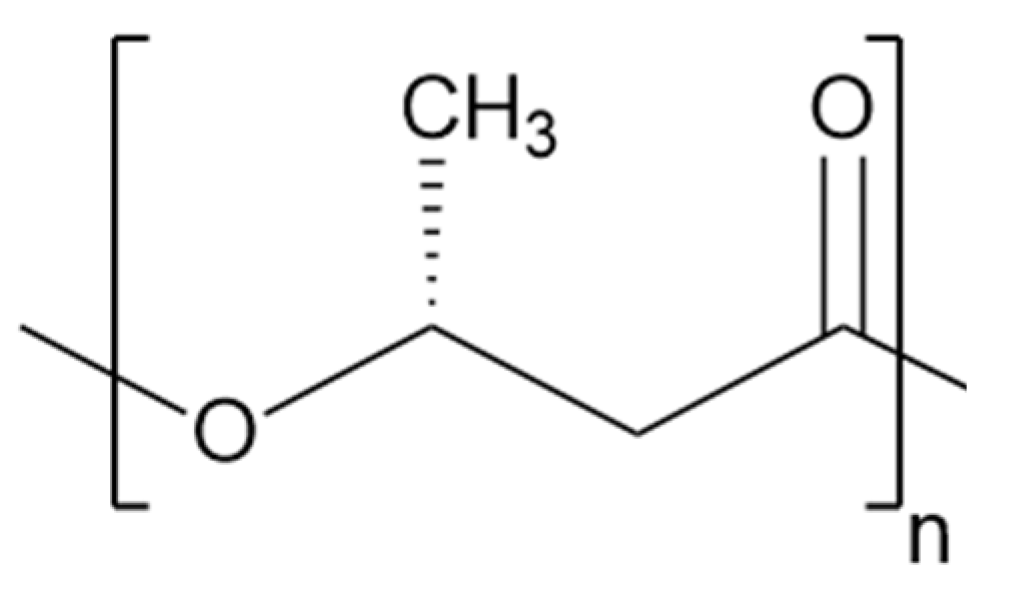


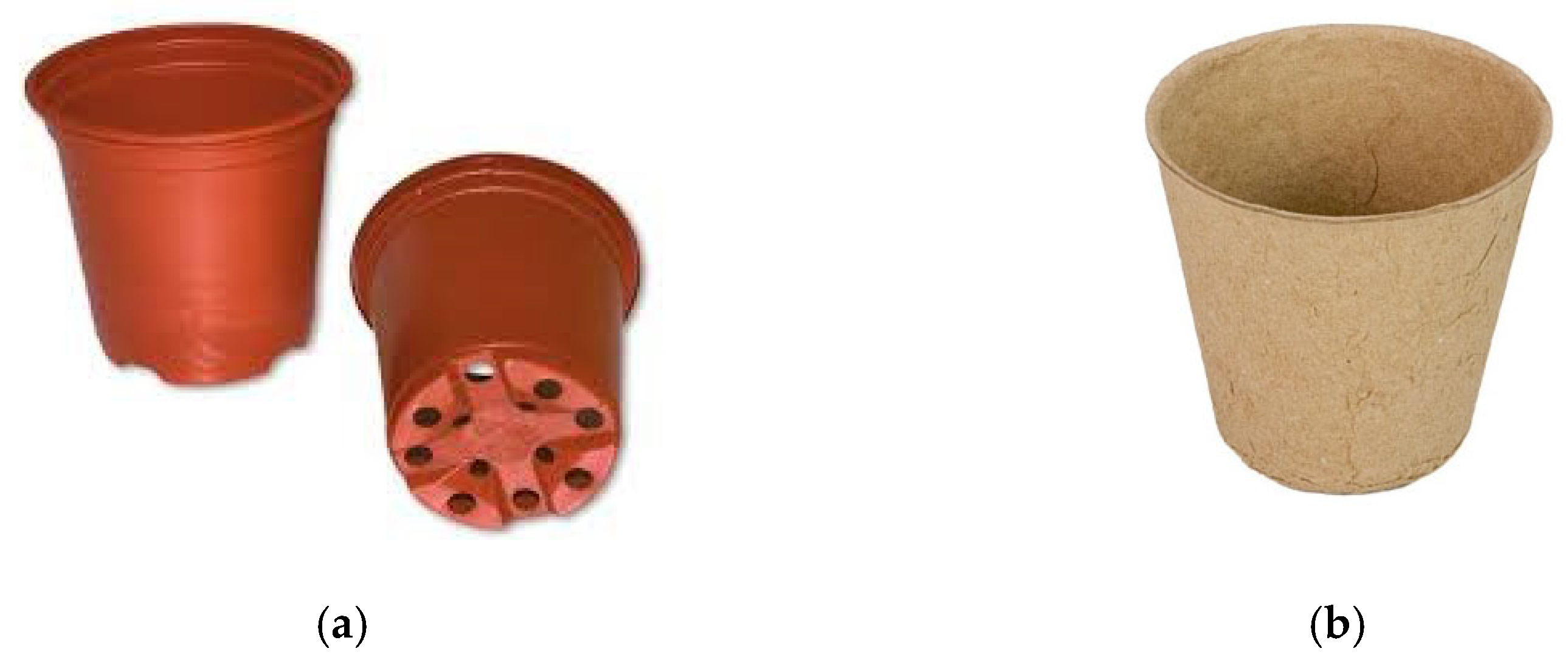
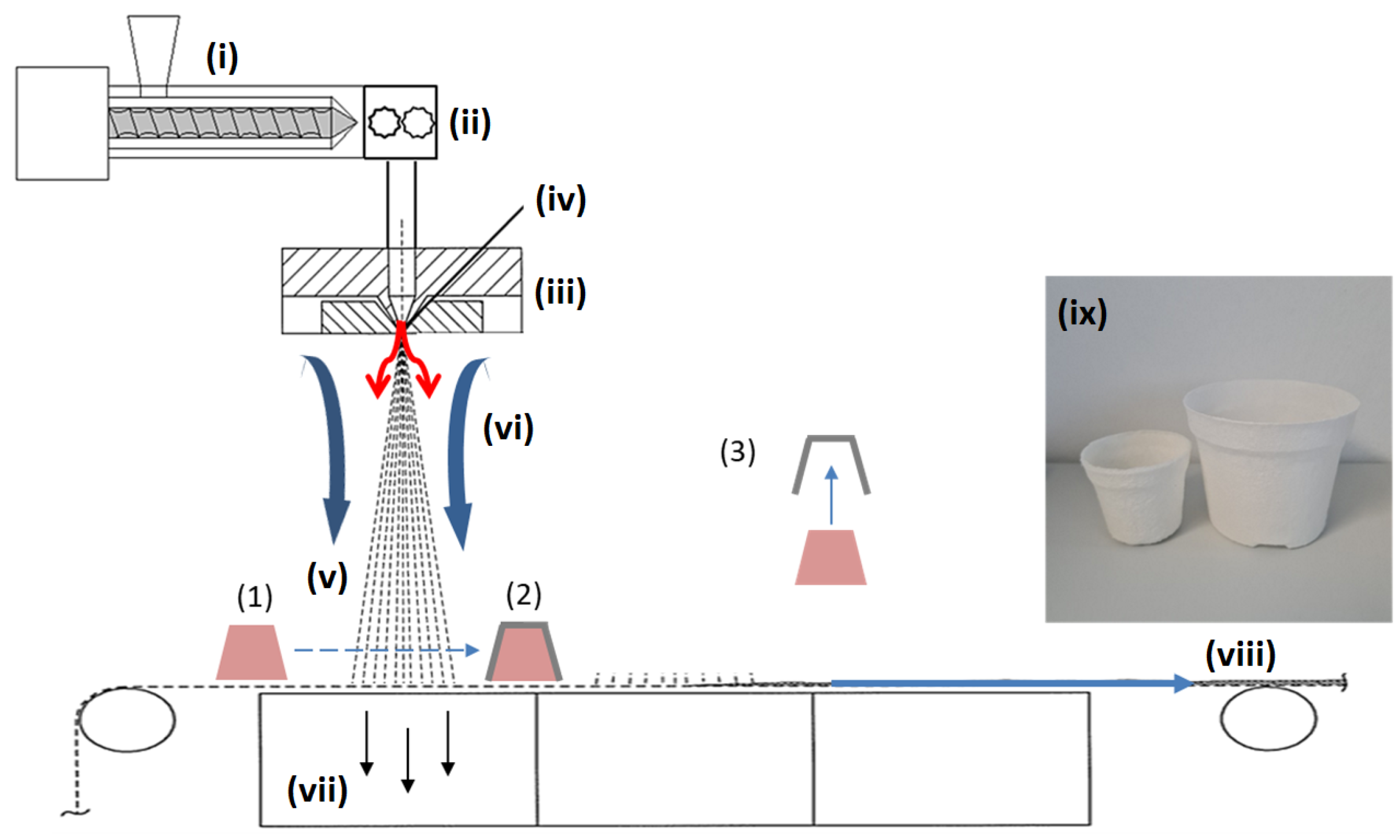
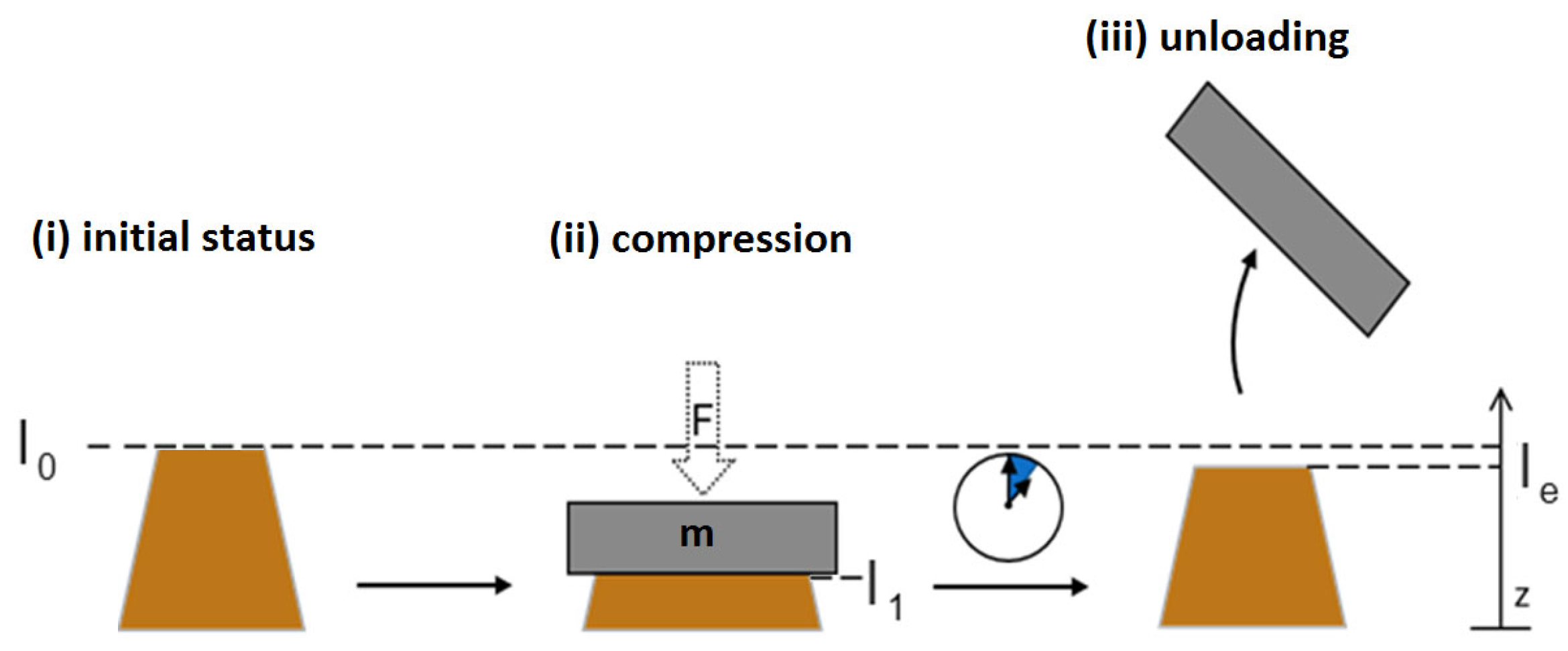
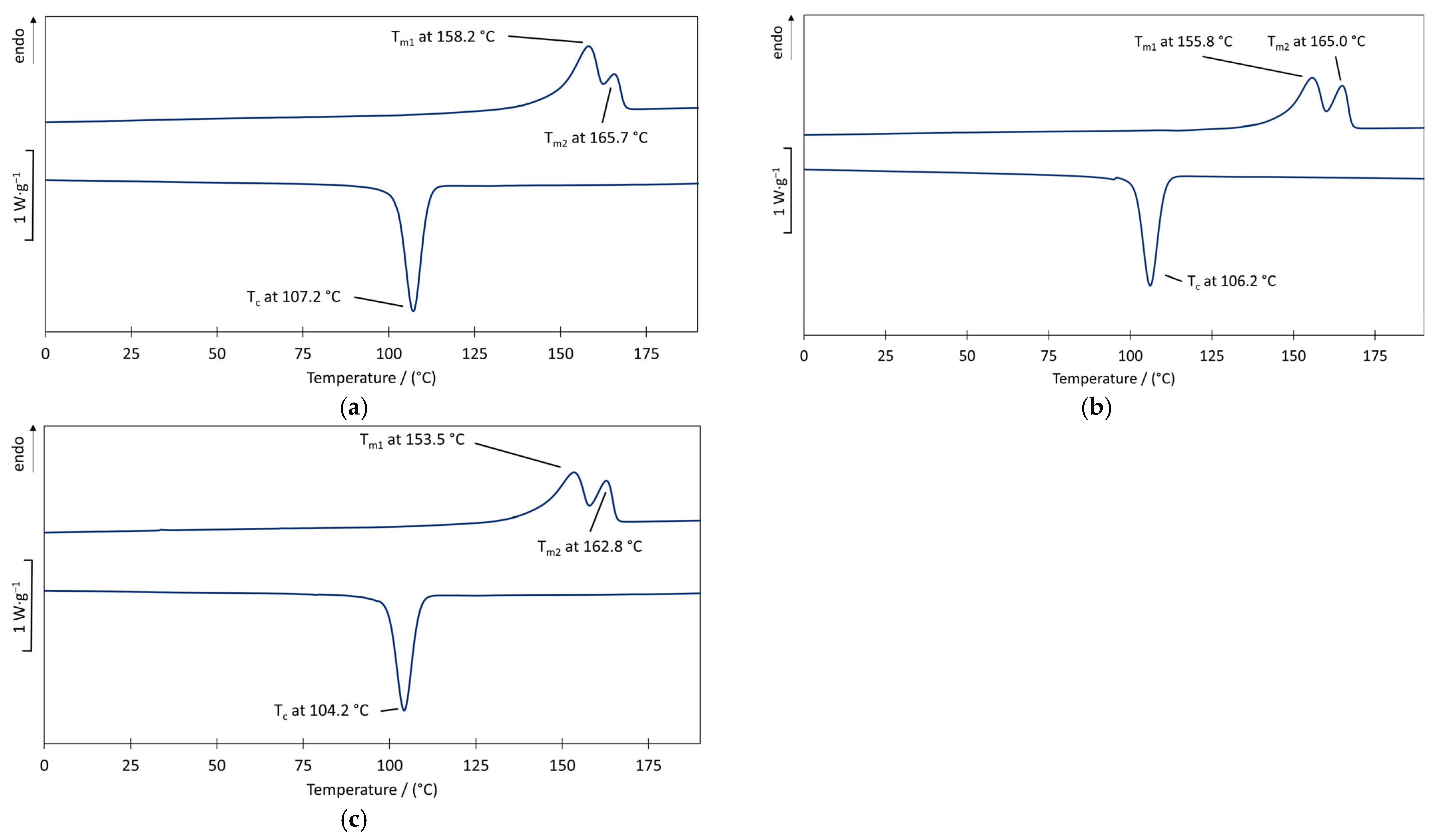


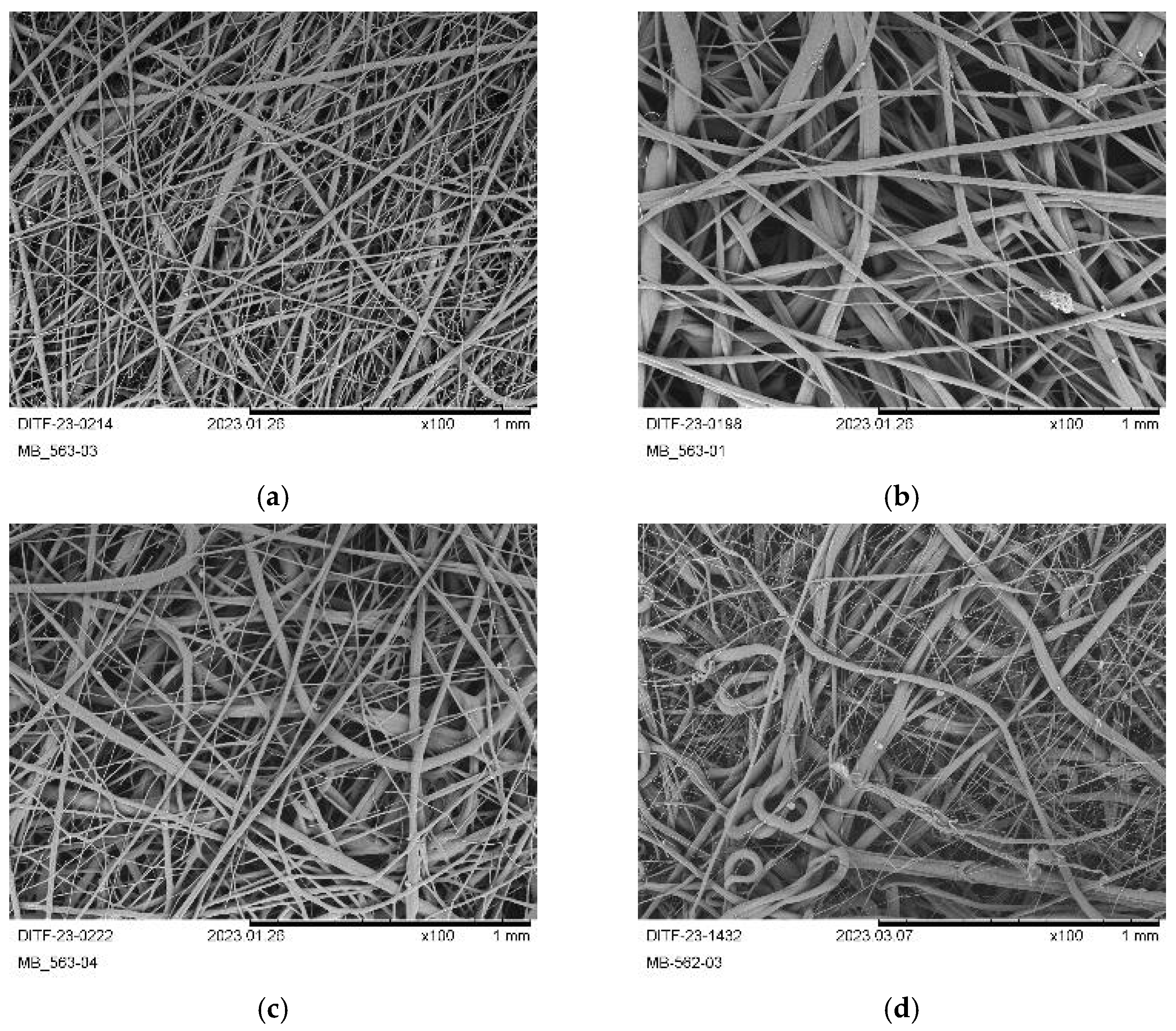
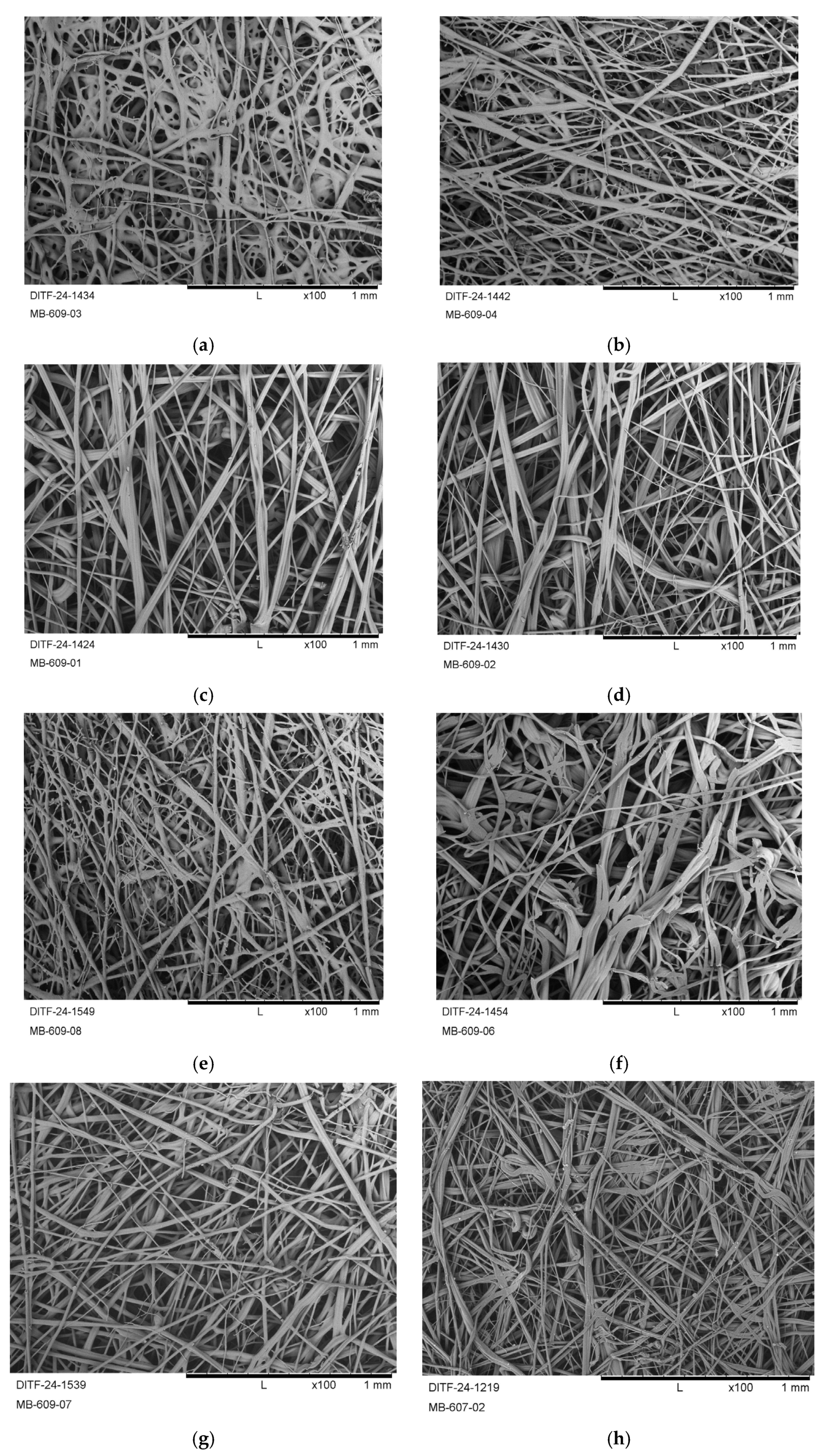

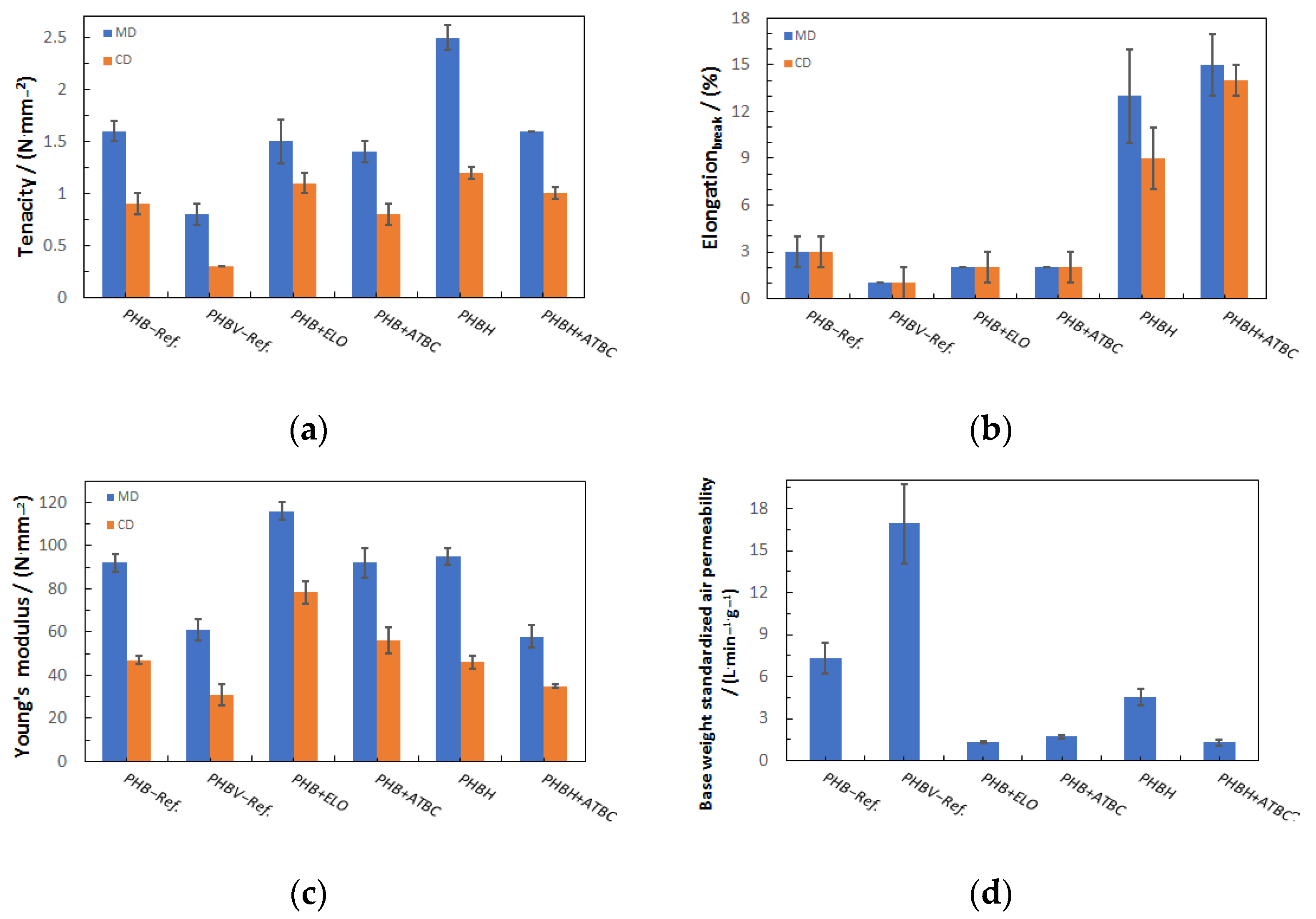
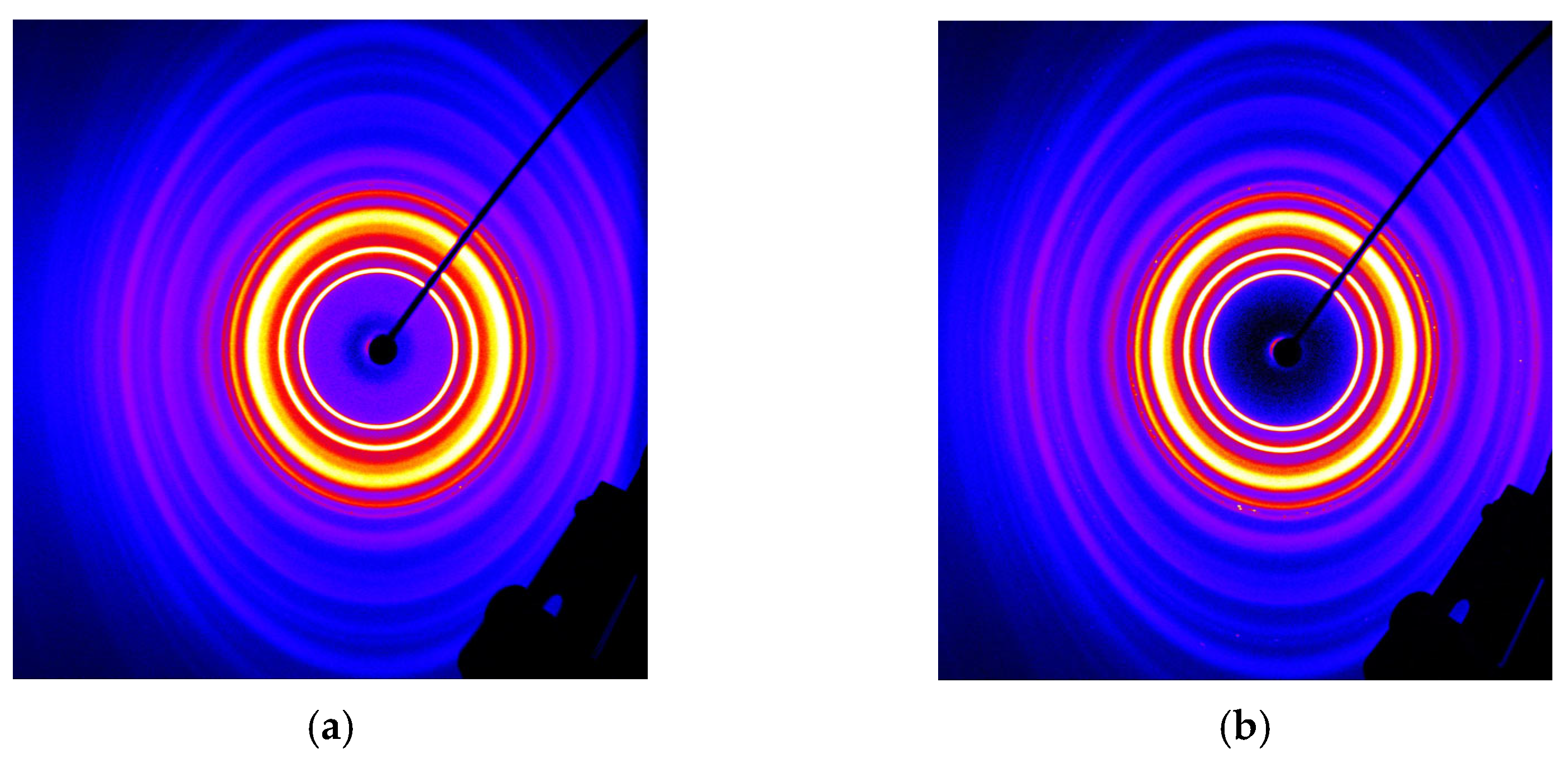

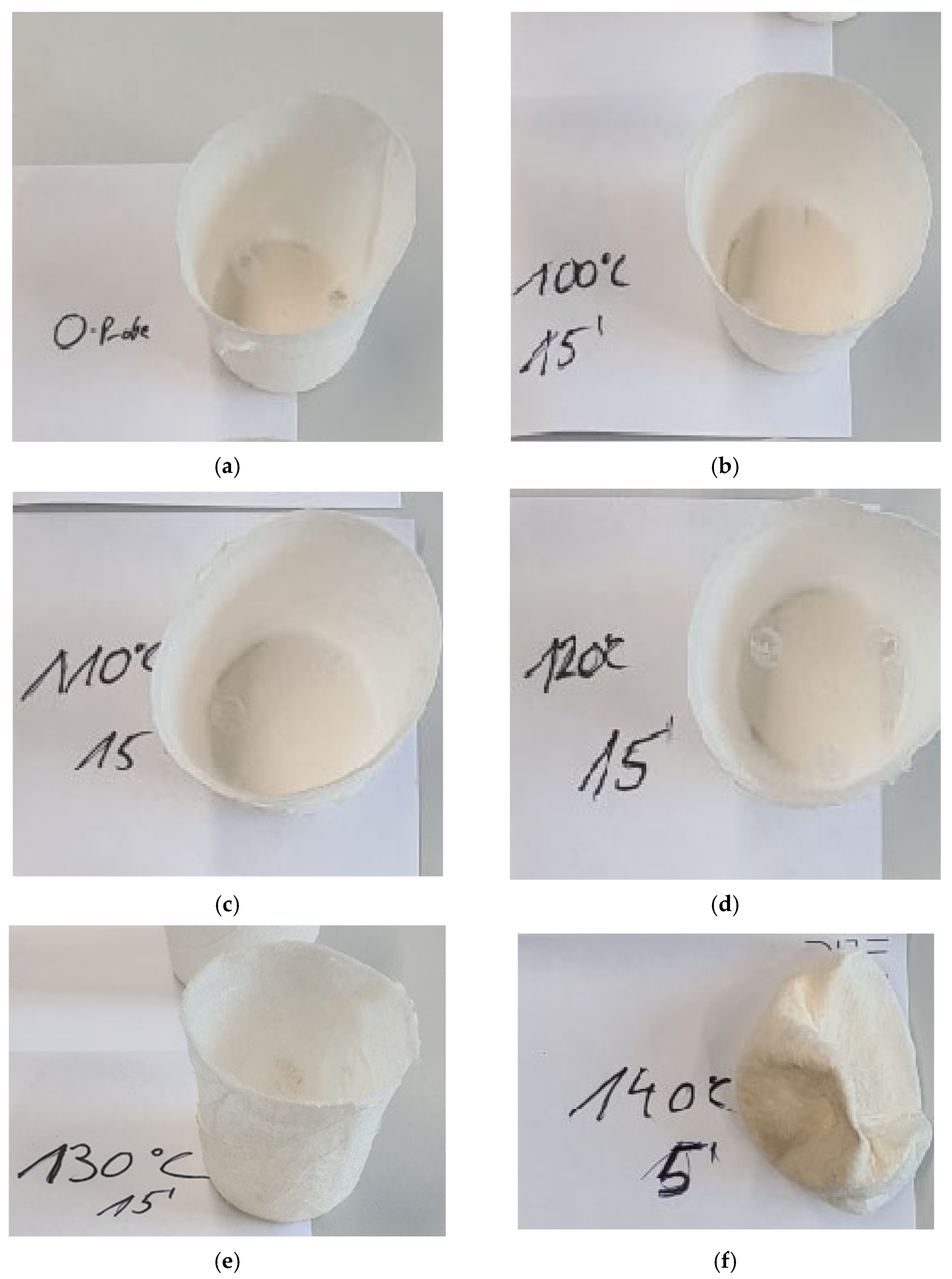
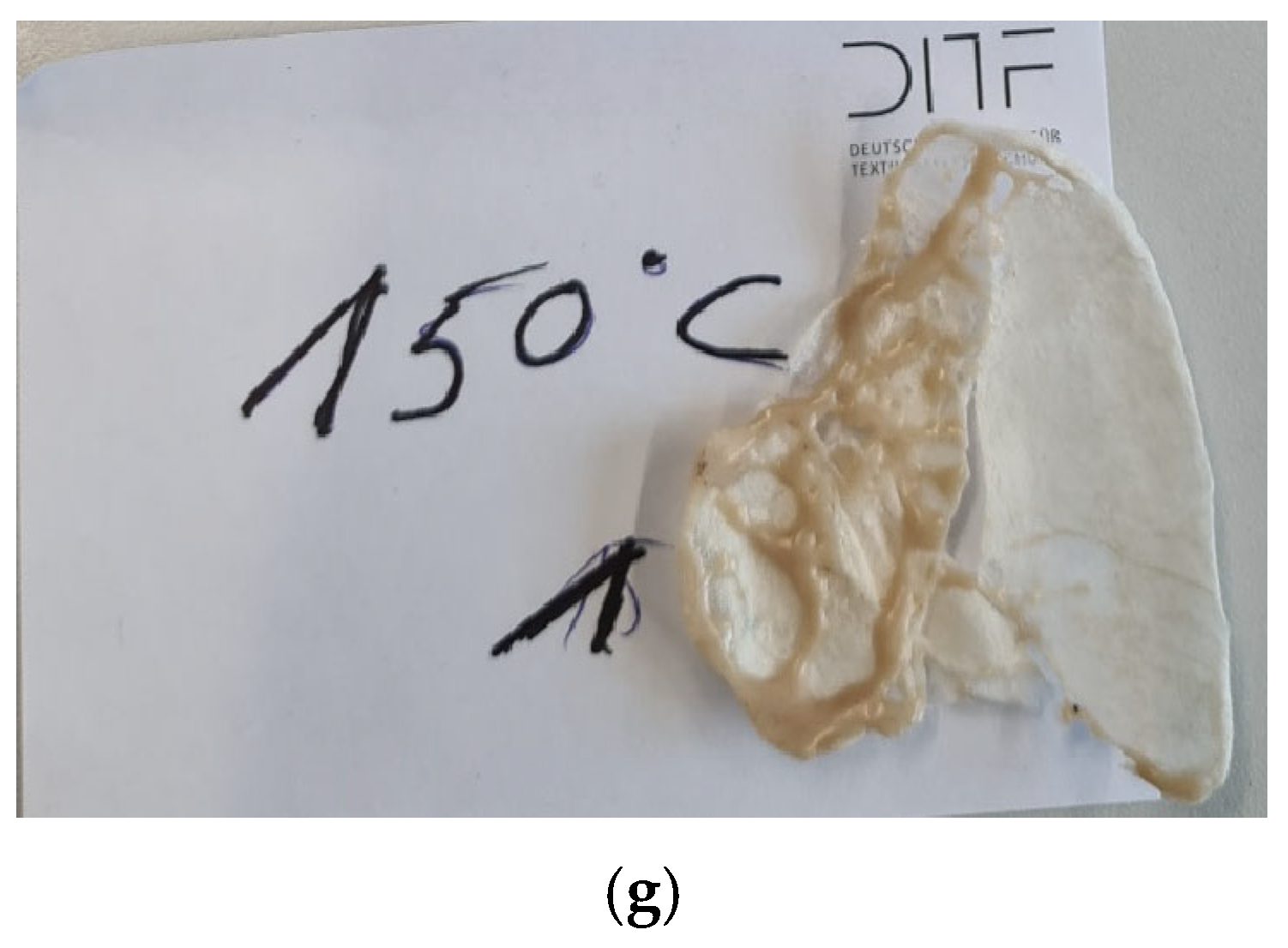
| Material | Ton/°C | T10%/°C | Tend/°C |
|---|---|---|---|
| P3HB | 277.9 | 284.0 | 306.4 |
| P3HB + 10 wt.% ELO | 275.3 | 252.0 | 311.7 |
| P3HB + 10 wt.% ATBC | 276.2 | 244.7 | 306.8 |
| PHBH | 277.1 | 275.0 | 295.9 |
| PHBH + 10 wt.% ATBC | 276.6 | 269.0 | 297.3 |
| Material | ηto (180 °C) /(Pa s) | G′t0 (180 °C) /Pa | G″t0 (180 °C) /Pa | MFI /(g 10 min−1) 1 |
|---|---|---|---|---|
| P3HB | 137 | 250 | 1354 | 10 [43] |
| PHBV | 434 | 684 | 4287 | 10–25 [56] |
| PHBH | 634 | 1150 | 6242 | 3 [44] |
| P3HB+ELO | 37 | 30 | 373 | - |
| P3HB+ATBC | 38 | 33 | 380 | - |
| PHBH+ATBC | 245 | 252 | 2405 | - |
| Material | Tproc /°C | ηto (Tproc) /(Pa·s) | η300s (Tproc) /(Pa·s) | G′t0 (Tproc) /Pa | G″t0 (Tproc) /Pa |
|---|---|---|---|---|---|
| P3HB | 180 | 137 | 67 | 250 | 1354 |
| PHBV | 200 | 227 | 49 | 199 | 2262 |
| PHBH | 190 | 325 | 52 | 151 | 3621 |
| P3HB+ELO | 176 | 48 | 36 | 47 | 476 |
| P3HB+ATBC | 176 | 45 | 37 | 41 | 445 |
| PHBH+ATBC | 190 | 62 | 18 | 17 | 623 |
| Trial-Nr. | Tmelt /°C | Tair /°C | Throughput /(g ho−1 min−1) | Die-Pressure /bar | Air Volume Flow /(Nm3 h−1) | Limitation(s) |
|---|---|---|---|---|---|---|
| P3HB-Ref–01 | 180 | 175 | 0.077 | 31.0 | 220 | – |
| P3HB-Ref–02 | 180 | 170 | 0.077 | 21.7 | 220 | |
| P3HB-Ref–03 | 180 | 175 | 0.077 | 21.8 | 325 | |
| PHBV-Ref | 200 | 195 | 0.051 | 26.4 | 325 | No stable process at lower throughput (degradation dominates) Limitation of max. throughput (die-pressure) |
| P3HB+ELO–01 | 176 | 170 | 0.039 | 7.1 | 220 | Edges stick strongly to conveyor belt |
| P3HB+ELO–02 | 176 | 170 | 0.039 | 7.1 | 325 | |
| P3HB+ELO–03 | 176 | 170 | 0.077 | 12.3 | 220 | |
| P3HB+ELO–04 | 176 | 170 | 0.077 | 12.3 | 325 | |
| P3HB+ATBC–01 | 176 | 170 | 0.039 | 23.5 | 220 | – |
| P3HB+ATBC–02 | 176 | 170 | 0.077 | 25.0 | 220 | The higher the throughput, the more inhomogeneous the deposition |
| P3HB+ATBC–03 | 176 | 170 | 0.077 | 25.0 | 325 | |
| PHBH | 190 | 185 | 0.032 | 35.0 | 325 | Limitation of max. throughput (die pressure) |
| PHBH+ATBC–01 | 190 | 185 | 0.032 | 47.2 | 220 | High pressure level → throughput limited |
| PHBH+ATBC–02 | 190 | 185 | 0.032 | 52.0 | 325 | |
| PHBH+ATBC–03 | 190 | 178 | 0.039 | 46.4 | 240 |
| Trial-Nr. | Base Weight | Thickness | Fiber Diameter | Air Permeability | Tenacity | Elongation 2 | Modulus 3 | ||
|---|---|---|---|---|---|---|---|---|---|
| /(g m−2) | CV 1 /% | /µm | Median /µm | Mean /µm | /(L m−2 s−1) | MD/CD /(N mm−2) | MD/CD /% | MD/CD /(N mm−2) | |
| P3HB–Ref–01 | 93 | 11 | 235 ± 19 | 4.6 | 7.0 | 680 ± 100 | 1.6 ± 0.1/0.9 ± 0.1 | 4 ± 1/5 ± 1 | 92 ± 4/47 ± 2 |
| P3HB-Ref–02 | 94 | 14 | 346 ± 43 | 13.7 | 16.2 | 4640 ± 880 | 0.7 ± 0.1/0.5 ± 0.1 | 3 ± 1/3 ± 1 | 39 ± 7/28 ± 4 |
| P3HB-Ref–03 | 99 | 16 | 299 ± 40 | 7.3 | 12.7 | 1550 ± 430 | 1.4 ± 0/0.7 ± 0.2 | 3 ± 0/3 ± 1 | 76 ± 5/38 ± 7 |
| PHBV-Ref | 120 | 8 | 566 ± 79 | 3.5 | 4.8 | 2030 ± 340 | 0.8 ± 0.1/0.3 ± 0 | 1 ± 0/1 ± 1 | 61 ± 5/31 ± 5 |
| P3HB+ELO–01 | 220 | 5 | 456 ± 55 | 10.6 | 16.7 | 285 ± 14 | 1.5 ± 0.2/1.1 ± 0.1 | 2 ± 1/2 ± 1 | 116 ± 4/78 ± 5 |
| P3HB-ELO–02 | 228 | 7 | 434 ± 34 | 10.5 | 12.8 | 230 ± 61 | 1.8 ± 0.1/1.0 ± 0.1 | 2 ± 0/2 ± 1 | 107 ± 5/69 ± 2 |
| P3HB+ELO–03 | 223 | 12 | 562 ± 118 | 9.3 | 11.3 | 863 ± 156 | 1.1 ± 0.1/0.6 ± 0.1 | 3 ± 0/2 ± 1 | 53 ± 6/36 ± 4 |
| P3HB+ELO–04 | 204 | 18 | 504 ± 132 | 7.3 | 9.8 | 537 ± 125 | 1.3 ± 0.1/1.0 ± 0.1 | 3 ± 0/2 ± 1 | 71 ± 6/54 ± 9 |
| P3HB+ATBC–01 | 188 | 12 | 373 ± 52 | 8.8 | 12.0 | 390 ± 19 | 1.4 ± 0.1/0.8 ± 0.1 | 2 ± 0/2 ± 0 | 92 ± 7/56 ± 6 |
| P3HB+ATBC–02 | 213 | 12 | 516 ± 102 | 14.2 | 15.9 | 765 ± 65 | 1.0 ± 0.1/0.6 ± 0.2 | 2 ± 0/2 ± 1 | 69 ± 12/36 ± 7 |
| P3HB+ATBC–03 | 204 | 14 | 454 ± 106 | 7.4 | 10.0 | 543 ± 45 | 1.3 ± 0.1/0.8 ± 0.2 | 2 ± 1/2 ± 1 | 93 ± 17/47 ± 4 |
| PHBH | 128 | 11 | 390 ± 48 | 4.5 | 6.2 | 700 ± 69 | 2.5 ± 0.1/1.2 ± 0.1 | 5 ± 0/6 ± 0 | 100 ± 2/4 ± 1 |
| PHBH+ATBC–01 | 140 | 12 | 335 ± 26 | 6.5 | 7.9 | 185 ± 32 | 1.5 ± 0.1/1.2 ± 0 | 10 ± 2/22 ± 3 | 60 ± 2/41 ± 2 |
| PHBH+ATBC–02 | 131 | 11 | 343 ± 24 | 8.8 | 8.5 | 411 ± 101 | 1.6 ± 0/1.0 ± 0.1 | 15 ± 2/14 ± 1 | 58 ± 5/35 ± 1 |
| PHBH+ATBC–03 | 120 | 22 | 376 ± 69 | 3.6 | 6.4 | 270 ± 40 | 2.2 ± 0.1/1.1 ± 0.1 | 6 ± 0/10 ± 2 | 85 ± 5/45 ± 2 |
| Material | P3HB | P3HB+ECO | P3HB-ATBC | PHBV | PHBH | PHBH+ATBC |
|---|---|---|---|---|---|---|
| Shrinkage in MD/% | 1.7 ± 0.6 | 1.9 ± 0.6 | 1.3 ± 0.5 | 1.6 ± 0.6 | 1.7 ± 0.8 | 1.5 ± 0.5 |
| Shrinkage in CD/% | 1 ± 1 1 | |||||
| Property | P3HB | PHBH | PHBV | Cellulose 1 | Coconut 1 |
|---|---|---|---|---|---|
| Area weight (g m−2) | 151 ± 12 | 151 ± 22 | 148 ± 3 | 296 ± 18 | 476 ± 43 |
| Wall thickness (µm) | 646 ± 84 | 409 ± 48 | 662 ± 49 | 1597 ± 120 | 2689 ± 294 |
| Tensile tenacity (N mm−2) | 1.6 ± 0.1 | 2.2 ± 0.1 | 0.8 ± 0.2 | 1.6 ± 0.4 | 0.7 ± 0.2 |
| Elongation (%) | 4 ± 1 | 13 ± 3 | 2 ± 1 | 3 ± 1 | 2 ± 0 |
| Youngs modulus (N mm−2) | 75 ± 19 | 95 ± 4 | 49 ± 7 | 73 ± 13 | 49 ± 7 |
| Air permeability (L m−2 s−1) | 2010 ± 74 | 676 ± 75 | 1060 ± 56 | 27 ± 3 | 114 ± 2 |
| Water retention (%) | 100 2 | 100 2 | 100 2 | 0 3 | 0 3 |
| Material | PHB 1 | PHBV | PHBH 2 |
|---|---|---|---|
| Result | 0.5 3 | 0 | 1 |
Disclaimer/Publisher’s Note: The statements, opinions and data contained in all publications are solely those of the individual author(s) and contributor(s) and not of MDPI and/or the editor(s). MDPI and/or the editor(s) disclaim responsibility for any injury to people or property resulting from any ideas, methods, instructions or products referred to in the content. |
© 2024 by the authors. Licensee MDPI, Basel, Switzerland. This article is an open access article distributed under the terms and conditions of the Creative Commons Attribution (CC BY) license (https://creativecommons.org/licenses/by/4.0/).
Share and Cite
Hiller, T.; Gutbrod, F.; Bonten, L.; Vocht, M.P.; Azimian, M.; Resch, J.; Bonten, C.; Winnacker, M. Generation of Bio-Based, Shape- and Temperature-Stable Three-Dimensional Nonwoven Structures Using Different Polyhydroxyalkanoates. Polymers 2025, 17, 51. https://doi.org/10.3390/polym17010051
Hiller T, Gutbrod F, Bonten L, Vocht MP, Azimian M, Resch J, Bonten C, Winnacker M. Generation of Bio-Based, Shape- and Temperature-Stable Three-Dimensional Nonwoven Structures Using Different Polyhydroxyalkanoates. Polymers. 2025; 17(1):51. https://doi.org/10.3390/polym17010051
Chicago/Turabian StyleHiller, Tim, Frederik Gutbrod, Louisa Bonten, Marc Philip Vocht, Mehdi Azimian, Julia Resch, Christian Bonten, and Malte Winnacker. 2025. "Generation of Bio-Based, Shape- and Temperature-Stable Three-Dimensional Nonwoven Structures Using Different Polyhydroxyalkanoates" Polymers 17, no. 1: 51. https://doi.org/10.3390/polym17010051
APA StyleHiller, T., Gutbrod, F., Bonten, L., Vocht, M. P., Azimian, M., Resch, J., Bonten, C., & Winnacker, M. (2025). Generation of Bio-Based, Shape- and Temperature-Stable Three-Dimensional Nonwoven Structures Using Different Polyhydroxyalkanoates. Polymers, 17(1), 51. https://doi.org/10.3390/polym17010051










